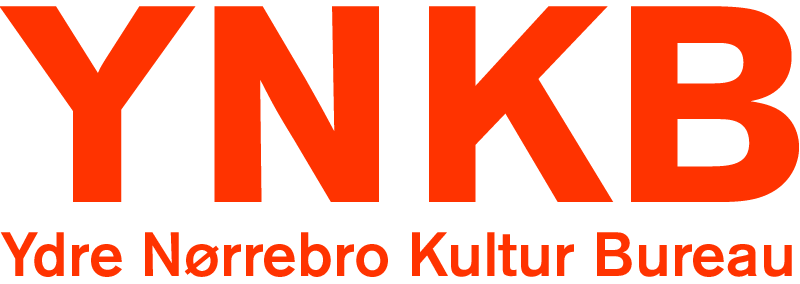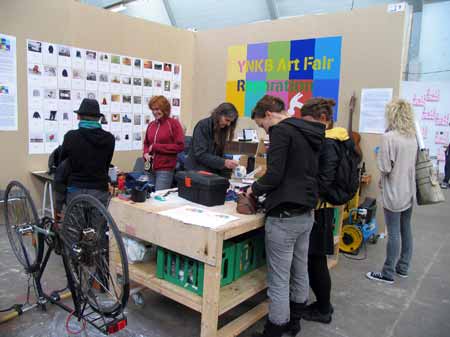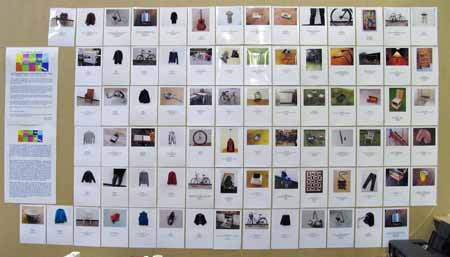September 21-22-23 2007
YNKB Art Fair Reparation

YNKB stand
The YNKB repair workshop on Copenhagen Alternative Art Fair in function
Jessica and Anna sewing
Stoffer is gluing the sewing box
All the repaired objects
See all the repaired objects from YNKB Art Fair Reparation
Through recycling and repairs, utilitarian objects to which we are attached can be renovated.
It is a way of giving things value, another meaning, and a new aesthetics, when these mass
produced consumer goods are reworked and become unique objects. At the same time, another
form of economy is created in place of the market and the consumerism that is advertised everywhere.
In the media, ecology is about cars and windmills; recycling and repairs are not valued as
a social-economic, resource-saving alternative.
Waste is one of the greatest societal problems – also at the global level. Using the browser Alltheweb on
29th of November 2002 gave 17.5 million hits for waste, whereas terror gave 7.3 million, poverty 6.5 million,
unemployment 3.7 million, racism 3 million, and hunger 1.5 million. Google and other browsers gave
similar results (see Zygmunt Bauman: Wasted Life, p.35). This involves material waste, where consumerism
and demand for new goods creates ever larger rubbish heaps. But it is unfortunately also about human waste
– people who are not needed, both in industrial and especially developing countries, where groups in the
population have become superfluous and are fleeing, are kept in slum areas and refugee camps without any future,
or are hunted like animals at Europe’s and USA’s borders.
Repair days will hardly solve the world’s waste problems but can perhaps provide an occasion to consider whether
an object has really served its purpose and must be sent to the dump, or whether its lifetime can be extended by using
a little ingenuity. It is also fun and maybe the most sensible form of creativity in a world where almost everything has been
invented and the hunt for something new has become absurd. Nothing indicates that greater productivity or inventions of
ever more things and consumer goods can either save or change the world, on the contrary. So why not be happy with
what we already have and try to make it function again?
YNKB
Consumerism is a culture of addiction, driving its subjects to the consumption of ever-newer, “immaculate” products,
in search of an ever-diminishing sense of satisfaction, always fleeting and never fully realized. Its most highly prized
commodities come packaged in promises of enhanced pleasure, largely defined by increasing its purchaser’s desirability
on the open market. In this situation, even a supposedly utilitarian object is defined less by its intrinsic value than by
extrinsic needs imposed upon it for ulterior purposes, namely the consumer’s need for not only self-esteem, but, ironically,
a sense of self in the first place.
Two of the many factors constraining an objects ability to do this, is when it breaks in a way disallowing its restoration
to the original condition or when it shows wear, both, exposing the owner to the symbolic threat of imperfection, vulnerability
and death, hence the need for disposal and replacement.
As a healthy and, unfortunately, increasingly unusual response to this, Kirsten and Finn have initiated a project of restoring
and repairing discarded objects, not with a view to returning them to some “perfect” condition, once again satisfying the
aforementioned extrinsic “needs,” but so as to return them to intrinsic utility, without trying to hide the effects of accident,
time and use, but to find within these the chance for singularization.
A beautiful precedent for this can be found in Zen pottery that uses chips and breaks in the object that, rather than devaluing it,
are an opportunity for the introduction of new color and mark. Like this pottery, the aesthetic affirmed by Kirsten and Finn’s
project isn’t one of impossible completion and finality, ironically subverted, covertly, in the interest of new consumption,
but one of open participation and change that doesn’t hide from life signs of fragility and death, but, rather, finds in these
sources for the introduction of creativity giving rise to the new.
Keith S. Pirlot





